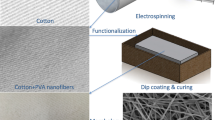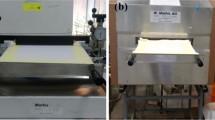Abstract
Surface functionalization of textiles is crucial in developing protective clothing that protects wearers from potential hazards of liquid, chemical and biological contamination. This study aims to explore chemical and water protective surface on cotton fabric by pad-knife-pad coating of waterborne polyurethane (WPU), polydimethylsiloxane (PDMS) and trimethylated silica (TMS). The chemical structure of the coated cotton fabrics was characterized by attenuated total reflectance Fourier transform infrared spectroscopy. Surface wettability and liquid protective properties of the coated cotton fabrics were analyzed by water contact angle, water repellency, hydrostatic pressure, and oil and aqueous liquid repellency. It was revealed that WPU and PDMS-TMS formed copolymerization reactions, resulting in ultrahydrophobic, oil repellent and mechanically strong membrane on the surface of cotton fabric. It has been found that the coating of WPU-PDMS-TMS makes cotton fabric highly resistant to water, oil and aqueous liquids. This surface functionalization technology can be further applied in developing protective clothing with chemical and water resistant and self-cleaning properties.









Similar content being viewed by others
References
Borisova A, Reihmane S (2013) Hydrophobic treatment of blended fabric’s surface. Mater Sci 19(2):169–173
Butruk B, Ziętek P, Ciach T (2011) Simple method of fabrication of hydrophobic coatings for polyurethanes. Cent Eur J Chem 9(6):1039–1045
Chen RS, Chang CJ, Chang YH (2005) Study on siloxane-modified polyurethane dispersions from various polydimethylsiloxanes. J Polym Sci Part A Polym Chem 43(16):3482–3490
Colleoni C et al (2015) Hydrophobic behaviour of non-fluorinated sol–gel based cotton and polyester fabric coatings. J Ind Text 44(6):815–834
Daoud WA, Xin JH, Tao X (2004) Superhydrophobic silica nanocomposite coating by a low-temperature process. J Am Ceram Soc 87(9):1782–1784
Fang J et al (2012) Superhydrophobic nanofibre membranes: effects of particulate coating on hydrophobicity and surface properties. J Text Inst 103(9):937–944
Hekster FM et al (2002) Perfluoroalkylated substances: aquatic environmental assessment. Rijkswaterstaat-RIKZ, Netherlands
Jassal M et al (2004) Waterproof breathable polymeric coatings based on polyurethanes. J Ind Text 33(4):269–280
Jiang W-C et al (2006) A novel waterborne polyurethane containing short fluoroalkyl chains: synthesis, characterization and its application on cotton fabrics surface. Appl Surf Sci 253(4):2304–2309
Kang YK et al (2007) Application of electrospun polyurethane web to breathable water-proof fabrics. Fibers Polym 8(5):564–570
Lim H et al (2001) Synthesis and surface property of aqueous fluorine-containing polyurethane. J Colloid Interface Sci 241(1):269–274
Liu T et al (2012) Synthesis and characterization of UV-curable waterborne polyurethane acrylate possessing perfluorooctanoate side-chains. J Polym Res 19(2):1–8
Lomax GR (2007) Breathable polyurethane membranes for textile and related industries. J Mater Chem 17(27):2775–2784
Ozen I (2012) Multi-layered breathable fabric structures with enhanced water resistance. J Eng Fibers Fabr 7(4):63–67
Pergal M et al (2013) Surface and thermomechanical characterization of polyurethane networks based on poly (dimethylsiloxane) and hyperbranched polyester. Express Polym Lett 7(10):806–820
Rengasamy S, Mannari V (2013) Hydrophobic and oil-resistant coatings based on advanced green polyurethane dispersions. J Appl Polym Sci 130(6):3874–3884
Roe B, Zhang X (2009) Durable hydrophobic textile fabric finishing using silica nanoparticles and mixed silanes. Text Res J 79(12):1115–1122
Satam D, Lee HJ, Wilusz E (2010) An approach to mass customization of military uniforms using superoleophobic nonwoven fabrics. AATCC Rev Mag Text Dye Print Finish Ind 10(5):59–63
Vazquez F (2005) Silicone softeners for stain repellent and stain release fabric finishing. Dow Corning Corporation, Greensboro
Wang H et al (2011) Durable, self-healing superhydrophobic and superoleophobic surfaces from fluorinated-decyl polyhedral oligomeric silsesquioxane and hydrolyzed fluorinated alkyl silane. Angew Chem Int Ed 50(48):11433–11436
Wu Z et al (2014) The effects of polydimethylsiloxane on transparent and hydrophobic waterborne polyurethane coatings containing polydimethylsiloxane. Phys Chem Chem Phys 16(14):6787–6794
Zeng C et al (2015) Self-cleaning, superhydrophobic cotton fabrics with excellent washing durability, solvent resistance and chemical stability prepared from an SU-8 derived surface coating. RSC Adv 5(75):61044–61050
Zhu M-J, Qing F-L, Meng W-D (2008) Novel waterborne polyurethanes containing short fluoroalkyl chains: synthesis and applications on cotton fabrics. J Appl Polym Sci 109(3):1911–1915
Acknowledgments
Technical assistances from Mr. Michael Jones are greatly appreciated.
Author information
Authors and Affiliations
Corresponding author
Rights and permissions
About this article
Cite this article
Moiz, A., Vijayan, A., Padhye, R. et al. Chemical and water protective surface on cotton fabric by pad-knife-pad coating of WPU-PDMS-TMS. Cellulose 23, 3377–3388 (2016). https://doi.org/10.1007/s10570-016-1028-5
Received:
Accepted:
Published:
Issue Date:
DOI: https://doi.org/10.1007/s10570-016-1028-5




